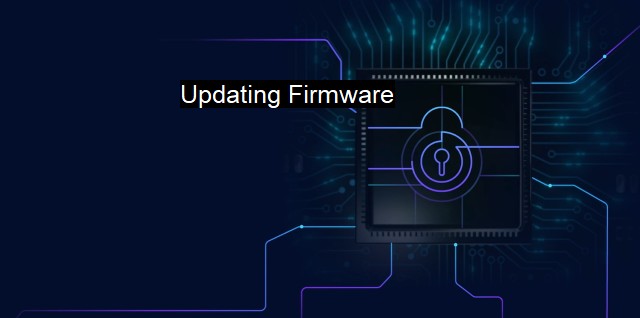What is Updating Firmware?
Staying Ahead of Cyber Threats: The Crucial Link between Up-to-Date Firmware and Strong Cybersecurity Defense
Updating firmware refers to the process of enhancing, amending, or optimizing the programmed instructions stored on a device's hardware component, commonly referred to as firmware. On the frontline of digital defense, this process is paramount to maintaining cybersecurity and preventing harm from malicious code or viruses.Firmware is essential software that operates as the foundational code for hardware devices. Embedded into a device's non-volatile memory, firmware guides the device on how to execute its core functions, from startup or booting to routine tasks. The data stored in the firmware remains unaltered even in the absence of power, making this storage integral to device functionality.
The process of updating firmware depends on the nature of the device, manufacturer's guidelines, and sometimes user preferences. Generally, the update involves downloading a new program code that amends or replaces parts of the existing firmware. Some devices come with inbuilt firmware auto-update functions whereas others necessitate manual updates.
Firmware updates not only add new features, improve device speed, and fix technical glitches, but also bring security patches, for mitigating cybersecurity risks. Just like other kinds of software, firmware can contain vulnerabilities, and these susceptibilities can furnish a gateway for hackers to jeopardize a system. Updating firmware, therefore, plays a central role in antivirus protection.
From the cybersecurity viewpoint, updating firmware also helps to keep pace with the continuous evolution of malware and cyber threats. Hackers skilled at crafting differing malicious codes to overcome security barriers make it necessary for firmware to be kept agile through the implementation of updates.
Relatively old firmware can lag in security standards, offering easy points of exploitation for hackers. Therefore, the importance of regular updates extends from consumer devices like routers or smart appliances to industry-level equipment, which broadcast a vast treasure trove of exploitable data if compromised.
Staying updated is not only about securing devices from well-known pre-existing threats but also defending against novel, unidentified risks. Zero-day attacks, which involve exploiting a previously unknown vulnerability before manufacturers can devise solutions, are becoming prevalent. Timely firmware updates can help in preventing these incidents, thereby augmenting security prowess.
Organizations, in particular, need to maintain a robust firmware update policy. Considering the potentially devastating consequences of breaches, exemplified by high-profile incidents like ransomware attacks on critical infrastructure, it is crucial to prevent devices such as servers, routers, or IoT equipment from falling into disrepair regarding security updates.
Failure to update firmware also propagates stratified, or layered, vulnerabilities where a small gap in security can open up an array of extensive system-wide exploits. This consequence is why firmware updates act as cornerstone policies in cybersecurity management frameworks.
Unfortunately, there’s a widespread complacency when it comes to updating firmware. One of the primary reasons being the inherent complexity of the update process or simply because manufacturers fail to communicate about it in a comprehensible manner. This ‘patch gap’ makes devices incredibly susceptible to attack and can lead to sensitive data loss and jeopardize overall system functionality.
Critically, firmware updates can address defects in coding, potentially fortifying firewalls against invasive viruses or malware, while filling in potential loopholes that antivirus software might overlook. Left undeterred and un-updated, these gaps could cause damaging malfunctions or even present backdoors for intrusive cybersecurity threats.
It becomes evident that the act of updating firmware occupies a critical position in a broad cybersecurity and antivirus framework. As cyber threats continue to proliferate, there's an escalating importance and urgency for individuals and organizations to adopt regular firmware update routines. In the rapidly progressing world of the Internet of Things and interconnected devices, the practice of keeping firmware updated will invariably pay dividends in terms of providing a more robust cybersecurity defense framework.

Updating Firmware FAQs
What is firmware and why is it important to update it?
Firmware is a type of software that controls the hardware devices of a computer or other electronic device. It is important to update firmware because it often contains security patches that address vulnerabilities in the system.How can I check if my device needs a firmware update?
You can check the manufacturer's website for any available updates or use the device's built-in update feature. Some devices may also send notifications when updates are available.What precautions should I take before updating firmware?
Before updating firmware, make sure to back up any important data on your device. Additionally, ensure that the device has sufficient battery life and is not connected to any external devices during the update process.What should I do if there is a problem during the firmware update process?
If there is a problem during the firmware update process, do not turn off the device or disconnect it from the computer. Contact the manufacturer's support team or seek help from a qualified technician to resolve the issue.| | A | | | B | | | C | | | D | | | E | | | F | | | G | | | H | | | I | | | J | | | K | | | L | | | M | |
| | N | | | O | | | P | | | Q | | | R | | | S | | | T | | | U | | | V | | | W | | | X | | | Y | | | Z | |
| | 1 | | | 2 | | | 3 | | | 4 | | | 7 | | | 8 | | |||||||